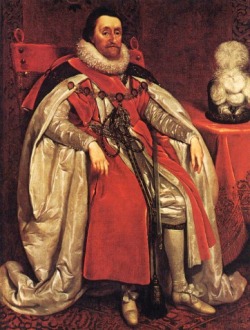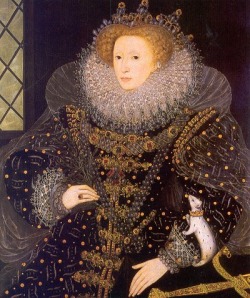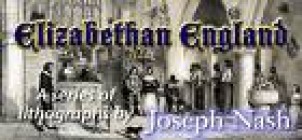King James I of England
By Lauren Cisney

This is King James I of England
King James I of England
King James I of England and Ireland was king from 1603 to 1625. He became king when he was only thirteen months old. James was born June 19, 1566. He automatically became Duke of Rothesay and Prince and Great Steward of Scotland. His mother was Mary, Queen of Scots, his father was Henry Stuart or Lord Darnley.. In March 1603, Elizabeth I died, James then ruled the Kingdom of England, Scotland and Ireland for 22 years. James was a talented scholar, writing many works such as Damonologie, True Law of Free Monarchies, and Basilikon Doron. When James was younger he showed little curiosity in women and preferred men. But in order to continue his monarchy, he had to marry a woman. He chose Anne of Denmark, age fourteen, daughter of Frederick II. Anne sailed for Scotland but was directed off course to the coast of Norway. James sailed to Norway to get Anne. The two were married at the Old Bishop's Palace in Olso on November 23. They then returned to Scotland in May 1590. It was said that Anne gave birth to seven children, but only three survived beyond birth. There were many rumors the James had love affairs with male courtiers. To be precise the male courtiers were Robert Carr, 1st Earl of Somerset; and George Villiers, 1st Duke of Buckingham. He also had a two year affair with Anne Murphy and later Lady Glamis, he wrote poetry to them. James died March 27, 1625, he was 58.
King James I of England and Ireland was king from 1603 to 1625. He became king when he was only thirteen months old. James was born June 19, 1566. He automatically became Duke of Rothesay and Prince and Great Steward of Scotland. His mother was Mary, Queen of Scots, his father was Henry Stuart or Lord Darnley.. In March 1603, Elizabeth I died, James then ruled the Kingdom of England, Scotland and Ireland for 22 years. James was a talented scholar, writing many works such as Damonologie, True Law of Free Monarchies, and Basilikon Doron. When James was younger he showed little curiosity in women and preferred men. But in order to continue his monarchy, he had to marry a woman. He chose Anne of Denmark, age fourteen, daughter of Frederick II. Anne sailed for Scotland but was directed off course to the coast of Norway. James sailed to Norway to get Anne. The two were married at the Old Bishop's Palace in Olso on November 23. They then returned to Scotland in May 1590. It was said that Anne gave birth to seven children, but only three survived beyond birth. There were many rumors the James had love affairs with male courtiers. To be precise the male courtiers were Robert Carr, 1st Earl of Somerset; and George Villiers, 1st Duke of Buckingham. He also had a two year affair with Anne Murphy and later Lady Glamis, he wrote poetry to them. James died March 27, 1625, he was 58.
"Photo Gallery." WillShakespeare. Web. 25 Feb. 2010.
<http://www.willshakespeare.com/pictures.htm>.
<http://www.willshakespeare.com/pictures.htm>.
Queen Elizabeth I
By Izzy DiGnazio

This is Queen Elizabeth I
Queen Elizabeth I was born on September 7th, 1533 in Greenwich, England. When she was first born it was not expected of her to take the throne of England, because she had two older sisters. Her older half-sister Mary had lost her position as legitimate heir as did her next to oldest sister Anne. When she did finally become queen she was twenty-five years old, her reign was from November 17,1558 until her death. At the coronation ceremony, on January 25, 1559, she was welcomed in whole heartedly by the citizens.
From the start of Queen Elizabeth's rein the question arose of whom she would marry. But Queen Elizabeth never did marry and reasons for this are unclear. There were some prospects but she never did choose one. As Elizabeth aged and marriage was unlikely, her image began to change. Her portraits were looking less realistic and more a set of icons that just made her look younger. In 1562 she was left scarred after suffering from smallpox so she relied on wigs and cosmetics for her portraits. Elizabeth's rein is known as the Elizabethan era. Famous for the flourishing of English drama, led by playwrights such as William Shakespeare and Christopher Marlowe. On March 24,1603 Queen Elizabeth I died at the age of sixty-two in Richmond England. Although many people mourned her death others were some what great full that she would no longer be ruling England.
** This picture was taken from Google.
From the start of Queen Elizabeth's rein the question arose of whom she would marry. But Queen Elizabeth never did marry and reasons for this are unclear. There were some prospects but she never did choose one. As Elizabeth aged and marriage was unlikely, her image began to change. Her portraits were looking less realistic and more a set of icons that just made her look younger. In 1562 she was left scarred after suffering from smallpox so she relied on wigs and cosmetics for her portraits. Elizabeth's rein is known as the Elizabethan era. Famous for the flourishing of English drama, led by playwrights such as William Shakespeare and Christopher Marlowe. On March 24,1603 Queen Elizabeth I died at the age of sixty-two in Richmond England. Although many people mourned her death others were some what great full that she would no longer be ruling England.
** This picture was taken from Google.
Elizabethan and Jacobean Era
By Shannon Perich

This is Elizabethan England
During the Elizabethan era, it was a rather prosperous age but, it ended with a war and serious debt which the Jacobean era had to fix.
Jacobean Era ranges from 1603 to 1623. The name of this era derives from King James I. Jacob is Hebrew version for James. From the war, King James had to deal with the debt of England which was about £350,000 but, was increasing about £140,000.King James was doomed when he inherited a terrible decision- that was doomed from the start. England suffered from the bubonic plague hit England around 1620; there was a terrible economic crisis. From 1620 to around 1626, England suffered from a terrible depression. This was a relatively dark time in England’s history and it ended on a terrible note.
During the Elizabethan era, is named after Queen Elizabeth I. It is also famous for the Virgin Queen but for the era itself. In the Elizabethan era’s prime was an artistic perspective. New ideas, new thinking, and literature and science started in this time era. Also the two main religions were Catholics and Protestants. Crime and punishment was usually the death penalty (not an issue) like hanging, being drawn or beheading. Execution all played its role in the Elizabethan time era. Ordinary people were accused of being witches or practicing witchcraft. An interesting fact about the Elizabethan era is that in 1562 Queen Elizabeth passed a new and harsher witchcraft law, leading to witch hunts and the prosecution of witches.
** This picture was taken from Google
Jacobean Era ranges from 1603 to 1623. The name of this era derives from King James I. Jacob is Hebrew version for James. From the war, King James had to deal with the debt of England which was about £350,000 but, was increasing about £140,000.King James was doomed when he inherited a terrible decision- that was doomed from the start. England suffered from the bubonic plague hit England around 1620; there was a terrible economic crisis. From 1620 to around 1626, England suffered from a terrible depression. This was a relatively dark time in England’s history and it ended on a terrible note.
During the Elizabethan era, is named after Queen Elizabeth I. It is also famous for the Virgin Queen but for the era itself. In the Elizabethan era’s prime was an artistic perspective. New ideas, new thinking, and literature and science started in this time era. Also the two main religions were Catholics and Protestants. Crime and punishment was usually the death penalty (not an issue) like hanging, being drawn or beheading. Execution all played its role in the Elizabethan time era. Ordinary people were accused of being witches or practicing witchcraft. An interesting fact about the Elizabethan era is that in 1562 Queen Elizabeth passed a new and harsher witchcraft law, leading to witch hunts and the prosecution of witches.
** This picture was taken from Google
Links
http://www.jesus-is-lord.com/kinginde.htm
http://www.elizabethan-era.org.uk/elizabethan-england.htm
http://www.harwich.edu/depts/history/pp/ap1/sld006.htm
http://www.jesus-is-lord.com/kinginde.htm
http://www.elizabethan-era.org.uk/elizabethan-england.htm
http://www.harwich.edu/depts/history/pp/ap1/sld006.htm
Works Cited
"Elizabethan England." Elizabethan and Jacobean Eras Similiaries and Differences. Web. 25 Feb. 2010. <http://www.elizabethanenglandlife.com/elizabethan-and-jacobean-eras.html>.
Marvel, Laura. Elizabethan England. San Deigo: Greehaven, 2002. Print.
Rowse, A.L. The Elizabethan Rennaissance. Chicago: Ivan R Dee, 1972. Print.
"Elizabethan England." Elizabethan and Jacobean Eras Similiaries and Differences. Web. 25 Feb. 2010. <http://www.elizabethanenglandlife.com/elizabethan-and-jacobean-eras.html>.
Marvel, Laura. Elizabethan England. San Deigo: Greehaven, 2002. Print.
Rowse, A.L. The Elizabethan Rennaissance. Chicago: Ivan R Dee, 1972. Print.
